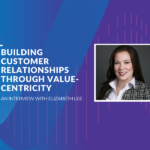The Current State Of “Outcome Selling”
‘Outcomes’ is currently one of the biggest buzzwords in both the Sales and Customer Success domains, and concepts like ‘outcome selling‘ have become wildly popular.
This trend cascades down to your Sales teams talking about achieving ‘outcomes’ with all of their prospects. Here’s how that conversation might go in a software company offering a sales enablement product:
Salesperson: “So, what outcome are you looking to achieve with our sales enablement product?”
Prospect: “We want to double our sales in the next year.”
Salesperson: “Great, that’s exactly the type of outcome our customers achieve. Let me tell you about some of our best product features…”
Sound familiar?
Perhaps the Sales team goes on to nail the product demo, gets agreement on price and lands the customer. Time to celebrate? No.
The pitfalls of unrealistic outcome selling
The previous example of outcome selling will have you acquiring customers who are at high risk of churn from day 1 of their subscription with your company. You’ll be acquiring customers who expect your company and product to deliver:
- An ‘outcome’ that is, in reality, more of a strategic vision, goal or Jim Collins-esque Big Hairy Audacious Goal (BHAG).
- An ‘outcome’ that depends on numerous variables outside of your control in order to achieve it. For example, if the customer’s product is priced too high for its target market, the odds of the company doubling its sales is pretty slim, no matter how good your sales enablement solution is.
- An ‘outcome’ that your customer success strategy is not designed to deliver.
In short, these customers expect an outcome that’s not possible for you to deliver. And, the customer will use that outcome (or lack thereof) to assess whether to renew or expand their investment in your product.
So how do you shift to realistic outcome selling that aligns your Sales and Customer Success teams and drives revenue retention and expansion?
You do it by prescribing outcomes that:
- Deliver measurable value to your customers.
- Combine to make a significant measurable contribution to the achievement of your customers’ strategic goals.
- Your customer success strategy and organization are designed to deliver to your ideal customer profile in a scalable, efficient manner.
At Valuize, we define ‘outcomes’ that meet the above criteria as value-based outcomes.
What exactly is a value-based outcome?
Value-based outcomes are prescriptive and measurable product adoption milestones that represent achieving or sustaining recurring value for customers.
Your customer must achieve value-based outcomes for your company to retain and expand that customer.
You must understand how to apply a prescriptive approach to outcome selling. For your company to efficiently and scalably retain and expand customers, you will need standardized ways of delivering recurring value for customers. This standardization begins with designing a set of outcomes that your customer success strategy can effectively, efficiently and scalably deliver. You should then prescribe these outcomes to your prospects and customers.
This is the opposite of simply asking your prospects what outcomes they want to achieve, saying, ‘sure, no problem’ to whatever they answer and then hoping your customer success strategy can deliver.
Being prescriptive in outcome selling will also improve your sales performance. Prospects and customers want to be prescribed to. This research by the CEB (now part of Gartner) reported that customers found it 86% easier to make a purchase from a prescriptive vendor and had 37% less post-purchase regret.
Designing value-based outcomes
To design prescriptive value-based outcomes and engage in achievable outcome selling, you need to identify the intersections between:
- Your ideal customer profiles’ strategic goals
- These customer profiles’ ‘jobs to be done’
- Your product’s features/functions
- The value enablers of that functionality
Please note the term ‘ideal customer profile‘. Value-based outcomes are not designed on a per customer-basis. They’re designed based on the overarching customer profile that your business wants to acquire and is capable of delivering value to.
Value-based outcomes are an important cog in your revenue and SaaS customer retention strategies, as well as in your customer expansion strategy. Therefore, your sales strategy should only acquire customers who fit within this cog.
You can assess whether your prospects are a fit by prescribing your predefined value-based outcomes to them during the sales cycle.
Prospects who don’t want to follow the plan to achieve the value-based outcomes you’re able to deliver should be disqualified from your sales pipeline. This will save them from becoming customers who fail to realize value from your product (i.e., customers who will worsen your revenue retention and expansion metrics).
Example: Applying value-based outcomes in the sales cycle
Let’s look at an example of a value-based outcome being applied in a sales cycle. The company and product names are made up for the purposes of this article.
SaaStastic offers a software product that helps software engineering teams reduce costs.
The company has defined its ideal customer profile and identified that its ideal customers are seeking to accomplish big reductions in their engineering programs’ costs (Ideal Customer Goal).
SaaStastic has also determined that QA testing (Ideal Customer Job) is a key job performed by its ideal customers, and that this job is typically a series of manual tasks.
SaaStastic has a QA testing module in its product (Product Feature). This feature enables QA testing to be largely automated (Value Enabler).
By analyzing the intersection between these four dimensions, SaaStastic has identified a value-based outcome. To enable reductions in the cost of its customers’ engineering programs (Ideal Customer Goal), SaaStastic knows its customers can achieve a 30-50% reduction in time spent on QA testing (Value-based Outcome) through automation (Value Enabler) enabled by adoption of the QA testing module (Product Feature).
Enter SoftWhip, an exciting new prospect for SaaStastic.
SoftWhip is seeking a 25% reduction in the cost of its software engineering program.
SaaStastic’s sales team prescribes the following to SoftWhip: adopting SaaStastic to achieve a 50% time reduction in SoftWhip’s QA process will be critical in accomplishing the desired overall cost reduction. SaaStastic then presents the adoption plan that SoftWhip would need to follow to effectively implement the QA testing module and achieve its goal.
In response, SoftWhip shares that it’s not willing to make the changes to its QA process required to adopt the automation functionality that SaaStastic provides. SoftWhip expects to achieve a 20-30% cost reduction without any changes to the QA process.
Despite SaaStastic’s best efforts to explain the value of the shift and how it can be effectively managed, SoftWhip refuses.
What should SaaStastic do?
Tell SoftWhip: “We hear you, and don’t worry. You won’t have to change your QA process. We’ll come up with a workaround or ask Product to make some revisions. Sign here please.”
This only works if SaaStastic is happy to:
- Invest expensive time and resources to then, 6 months later, explain to SoftWhip why the SaaStastic product can’t be changed and there’s no workaround
- Watch SoftWhip fail to adopt the product and churn
SaaStastic cannot sustain growth or achieve profitability by investing time in a doomed customer journey. SoftWhip doesn’t fit into SaaStastic’s ideal customer profile because it will not budge on its QA process. SaaStastic should disqualify the company as a prospect and not acquire its business, rather than fall into the trap of unrealistic outcome selling.
Level up your customer expansion strategy
By prescribing value-based outcomes during your sales cycles, you will:
- Decrease customer acquisition cost (CAC) spent on customers who are likely to churn (possibly before the CAC can even be paid back)
- Decrease customer retention cost (CRC) spent on customers who are still at high risk of churn despite the best efforts of Customer Success and Professional Services
- Reduce revenue and logo churn
- Increase customer expansion
What are the odds your next customer will be successful?
How many customers did your business acquire last month who don’t fit into your revenue retention and expansion engine?
Contact Valuize to learn how to effectively help your customers realize value.





